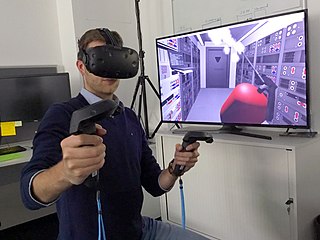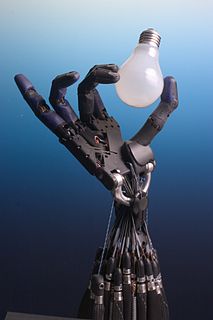
Chalmers University of Technology is a Swedish university located in Gothenburg that focuses on research and education in technology, natural science, architecture, maritime and other management areas.
Sirindhorn International Institute of Technology (SIIT) is a semi-autonomous institute of technology established in 1992 within Thammasat University. It is located in Pathum Thani, Thailand. One of Thailand's research universities, it offers science, technology and engineering education, as well as related management programs. All are international programs, with English language as a medium of instruction. The institute is part of the Links to Asia by Organizing Traineeship and Student Exchange network, an international consortium of universities in Europe and Asia.
Green computing, green ICT as per International Federation of Global & Green ICT "IFGICT", green IT, or ICT sustainability, is the study and practice of environmentally sustainable computing or IT.
The Virtual Reality Applications Center (VRAC) is a research center within the Engineering Teaching and Research Complex (ETRC) at Iowa State University (ISU) and is involved in advanced research of virtual reality (VR), augmented reality (AR), human computer interaction (HCI), visualization, and is home to the world's highest resolution immersive virtual reality facility, known as the C6.
László "Les" Bélády is a Hungarian computer scientist notable for devising the Bélády's Min theoretical memory caching algorithm in 1966 while working at IBM Research. He also demonstrated the existence of a Bélády's anomaly. During the 1980s he was the editor-in-chief of the IEEE Transactions on Software Engineering.

The Institute for Creative Technologies (ICT) is a research institute of the University of Southern California located in Playa Vista, California. ICT was established in 1999 with funding from the US Army.

Mahatma Gandhi University is an Indian collegiate public university based in Kerala. It was established on Gandhi Jayanti day, 2 October 1983 in the Kottayam district of Kerala state. Mahatma Gandhi University, has been approved by UGC and accredited (A) by the National Assessment and Accreditation Council of India. The university has around 300 affiliated colleges spread over five districts in central Kerala.
Telerehabilitation is the delivery of rehabilitation services over telecommunication networks and the internet. Most types of services fall into two categories: clinical assessment, and clinical therapy. Some fields of rehabilitation practice that have explored telerehabilitation are: neuropsychology, speech-language pathology, audiology, occupational therapy, and physical therapy. Telerehabilitation can deliver therapy to people who cannot travel to a clinic because the patient has a disability or because of travel time. Telerehabilitation also allows experts in rehabilitation to engage in a clinical consultation at a distance.

The Jordan University of Science and Technology, often abbreviated JUST, is a comprehensive, state-supported university located on the outskirts of Irbid, at Ar Ramtha in northern Jordan. Since its establishment in 1986, JUST has been at the forefront of institutions of higher learning in the Arab world, it also maintains a high reputation and standard amongst the universities of the Middle East. JUST and the University of Jordan in Amman are considered to be the two premier institutions of higher education for engineering and medicine in the country, although numerous other faculties and specializations are represented as well. The university was described as the best scientific institution in the Kingdom by King Abdullah II during a visit in November '10. As of the 2006/2007 academic year, JUST had 717 faculty members, with 20,000 undergraduate and 1559 graduate students, in contrast to 2,300 students in the 1986/1987 academic year. At the present time, the university comprises 12 faculties and 55 departments providing 52 bachelor's degree and 95 postgraduate programs. JUST comprised 5,415 international students of 61 nationalities in the academic year 2009/2010, rendering it the most cultural-diverse university in Jordan. It was ranked as the top research university in the country, and amongst the top 3% of universities in the Islamic world, according to a study carried out by the Statistical, Economic and Social Research and Training Center for Islamic Countries (SESRTCIC).
Virtual reality in telerehabilitation is a method used first in the training of musculoskeletal patients using asynchronous patient data uploading, and an internet video link. Subsequently, therapists using virtual reality-based telerehabilitation prescribe exercise routines via the web which are then accessed and executed by patients through a web browser. Therapists then monitor the patient's progress via the web and modify the therapy asynchronously without real-time interaction or training.
The IBM Cambridge Scientific Center was a company research laboratory established in February 1964 in Cambridge, Massachusetts. Situated at 545 Technology Square, in the same building as MIT's Project MAC, it was later renamed the IBM Scientific Center. It is most notable for creating the CP-40 and the control program portions of CP/CMS, a virtual machine operating system developed for the IBM System/360-67.
Justine Cassell is an American professor and researcher interested in human-human conversation, human-computer interaction, and storytelling. Since August 2010 she has been on the faculty of the Carnegie Mellon Human Computer Interaction Institute (HCII).
The Center for Robotics and Intelligent Machines (RIM@GT) is an interdisciplinary research unit at the Georgia Institute of Technology. The center was launched May, 2006, and consists of researchers from the School of Interactive Computing in the College of Computing, College of Engineering, and Georgia Tech Research Institute. RIM@GT currently offers a Ph.D. program in robotics, the first truly multi-disciplinary program in the country after the one of Carnegie Mellon University.
The terms dance technology and Dance and Technology refer to application of modern information technology in activities related to dance: in dance education, choreography, performance, and research.

Immersive technology refers to technology that attempts to emulate a physical world through the means of a digital or simulated world, thereby creating a sense of immersion. Immersive technology enables mixed reality; in some uses, the term "immersive computing" is effectively synonymous with mixed reality as a user interface.
OpenNebula is a cloud computing platform for managing heterogeneous distributed data center infrastructures. The OpenNebula platform manages a data center's virtual infrastructure to build private, public and hybrid implementations of infrastructure as a service. The two primary uses of the OpenNebula platform are data center virtualization solutions and cloud infrastructure solutions. The platform is also capable of offering the cloud infrastructure necessary to operate a cloud on top of existing infrastructure management solutions. OpenNebula is free and open-source software, subject to the requirements of the Apache License version 2.
ShanghaiTech University is a research university in Shanghai. Its campus is located in the Zhangjiang Hi-Tech Park in Pudong with an academic focus on STEM research. It has five schools and three research institutes and is backed by the Shanghai Municipal Government and China Academy of Science. In 2018, it had 1433 undergraduates, 1788 Master's and PhD students, and 485 faculty members.

Prof. Daniel Thalmann is a Swiss and Canadian Computer Scientist and a pioneer in Virtual Humans. He is currently Honorary Professor at EPFL, Switzerland, and Director of Research Development at MIRALab Sarl.
Video game rehabilitation, is a process of using common video game consoles and methodology to target and improve physical and mental weaknesses through therapeutic processes.Video games are becoming an integral part of occupational therapy practice in acute, rehabilitation, and community settings. The design for video games in rehabilitation is focused on a number of fundamental principles, such as reward, goals, challenge, meaningful play. ‘Meaningful play’ emerges from the relationship between player action and system outcome, apparent to the player through feedback. Platforms that feature motion control, notably the Nintendo Wii, Microsoft's Xbox Kinect, and Sony's Eye Toy, and virtual reality scenarios have all been effective in this field of research. Methodologies have been applied to all age groups, ranging from toddler to elderly aged people worldwide and have been used in a variety of cases ranging from stroke rehabilitation, cerebral palsy and other neurological impairments, to people with tendinitis and multiple sclerosis. Researchers have promoted such technology based on the personalization of gaming systems to patients which allows for further engagement and interaction. Additionally, gaming consoles have the ability to capture real-time data and provide instant feedback to the patients using the systems. Currently, several researchers have performed case studies to demonstrate the benefits of this technology, however, repeat trials and experiments have shown that outcomes are easily replicated among several groups worldwide. Additionally, the outcomes have increased interest in the field, growing experiments beyond simple case studies to experiments with larger participant basis.









